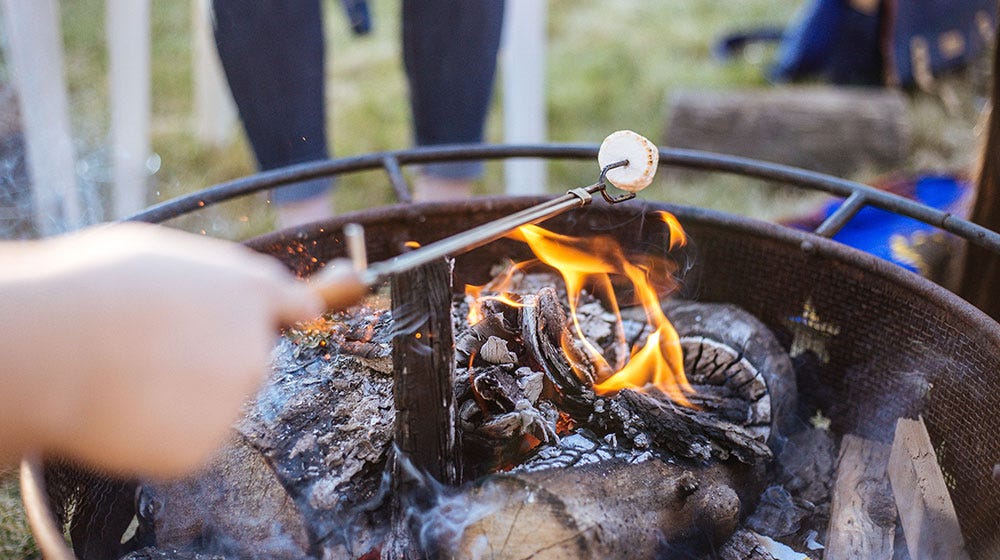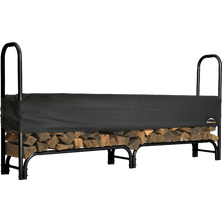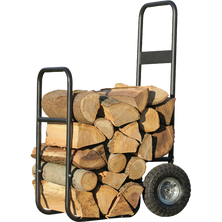There's nothing like sitting by a fire pit at the end of the day where you can relax with a favorite beverage in your hand. This is where you can share stories and reconnect with your friends and family, or simply take in the outdoor ambiance. The iconic crackle and warmth of a personal fire can make time appear to stand still and provide such a valuable atmosphere to the night. These cozy fires don't just happen by chance but are the result of using carefully prepared wood.
To get the most out of your fireplace, fire pit, or campfire, not just any firewood will do. Before you can enjoy a steady fire, you must properly season your firewood. This enables an easy burn that is steady and safe for your home. This guide will show you how to season your firewood by following some tried-and-true methods and with a firewood seasoning shed.
What Is Seasoning Firewood?
When one talks about seasoning firewood, they're not talking about throwing on some salt and pepper. Instead, seasoning refers to the process of allowing moisture to evaporate from the firewood.
When wood is first harvested from a tree, it is full of moisture. Burning wet wood can lead to poor fires, excessive smoke, and the production of the byproduct creosote. But by drying firewood, you can condition it to burn safely and efficiently. These basic firewood storage tips will show you how to dry out your firewood effectively so that you have an accessible stockpile of firewood for campfires, winter fireplaces, fire pits, and more.
Why Is It Important to Season Firewood?
Having firewood that burns more easily isn’t the only advantage of the seasoning process. If you try to burn freshly cut firewood, it can hold up to 45% of its internal moisture. Storing wet wood incorrectly leads to damp, moldy, and even rotting firewood.
Burning this wet wood also results in a more smoky burn that causes dangerous creosote buildup in chimneys. This natural byproduct is the leading cause of chimney fires and requires more frequent treatment from the chimney sweeping pros. When you burn wood outdoors, wet wood produces more smoke and uneven burns and results in frustrating fires that are difficult to stay lit.
What Do You Need to Season Firewood?
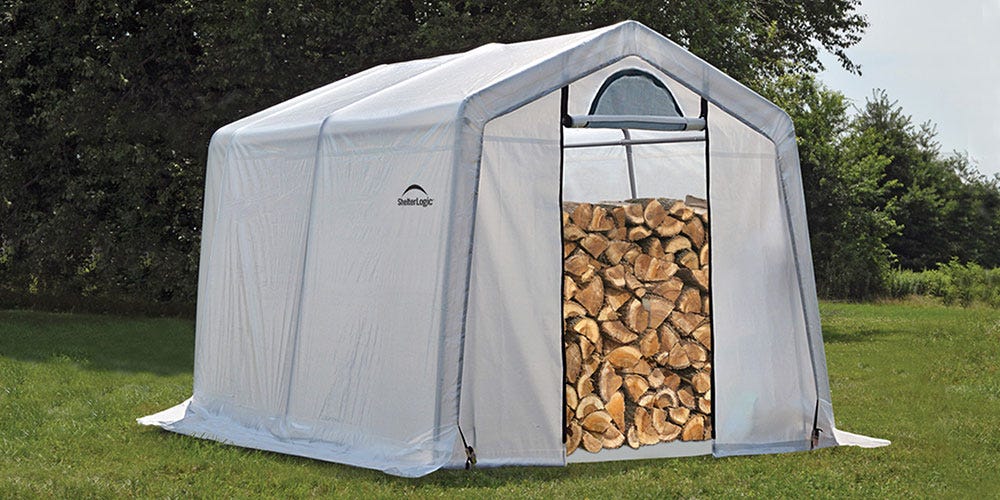

To season wood well, you need firewood storage with coverage and an ax for splitting logs into smaller pieces. When wood comes straight from the tree, the logs are often covered in bark. The bark is specifically there to keep the moisture inside the trunks. If you harvest logs from your property, you will need a designated spot to chop the wood into stackable pieces. This process exposes the inside of the log to the open air to fully dry it.
For the best seasoning process, store the logs in a place where they won't be exposed to any moisture but open to plenty of ventilation. Leaving logs out in the open isn’t advisable since rain will make them wet repeatedly. Solutions like storage sheds and firewood racks with covers are commonly used to season firewood.
When Do You Start Seasoning Firewood?
If you harvest wood from its source, the logs will need time to dry. This process should be started months in advance — at least six months — but up to a year is preferable. By prepping the wood, you can also speed up the process. Here are some steps to seasoning your wood more quickly:
- Split the wood with an ax to let the moisture escape the log so that it seasons more quickly.
- Store your wood outdoors in a covered yet ventilated shelter. This exposes the wood to enough airflow and sunlight to dry it efficiently.
It’s not advisable to place your wood outside unprotected. You should always cover your wood and store it in a shelter that is approved for firewood seasoning.
Seasoning Firewood to Get Value
When you buy seasoned firewood at the supermarket, they are typically marked up and come in small sets that just last one evening. But when you know how to prep your wood, you can score some real deals from people who need to get rid of wood from their property. Trees can be a nuisance or a danger to residents, and after they cut down the tree, there is usually nobody to take the wood. You can get cords of wood for excellent prices or even free when you know how to season wood yourself.
When you master the process, you can have a steady supply of affordable heating material. This is especially useful if you live in a cold climate where your home’s heating supply may be supplemented by a wood-burning stove. So, by investing in a spot to prep firewood, you can take full advantage of the “free firewood — you haul” posts on the internet!
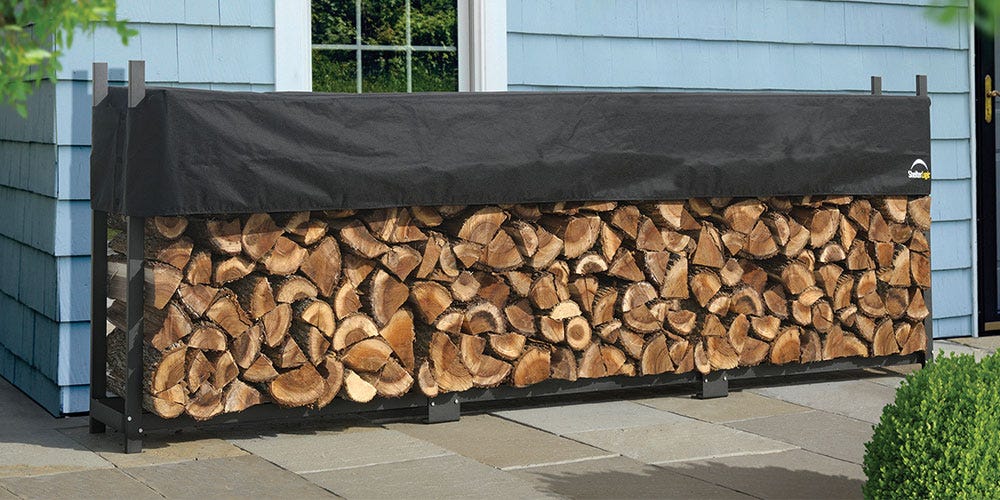

The Importance of Firewood Storage
By properly storing firewood, you can make sure it dries fully and stays protected from the elements. This ensures that your wood lasts a long time instead of decaying or rotting due to moisture or pest damage. For the best results, get firewood storage that is designed to keep wood dry and ventilated. Shelterlogic has a dependable line of firewood storage sheds and racks that are made just for this process.
What’s Special about a Firewood Seasoning Shed?
When it comes to the dos and don'ts of storing firewood, you should provide a dedicated place to protect and dry your wood. A firewood seasoning shed is designed to accelerate the drying process to be two times faster than open-air drying. These sheds are typically made with a heavy-duty steel frame, vapor barrier, waterproof cover, and a translucent polyethylene fabric cover to allow in light and keep in heat during the winter.
Firewood sheds are optimized to promote airflow, which is why good ones have screened vents to dry the wood faster compared to being left alone outside. As opposed to sheds that store yard equipment or tools, these structures are specifically designed to cover firewood racks and protect them from rain and pests while not keeping them fully enclosed.
Seasoning Sheds Protect Against Pests
When you invest in a seasoning shed and log rack, you can stop pests from eating away at your firewood. Wet wood attracts worms, termites, carpenter ants, and other pests that eat away at the wood. However, when you get a seasoning firewood shed kit, you can obtain the wood rack, vapor barrier, and physical barrier from direct outdoor exposure to keep away common pests. While racks and covers alone do a good job, a shed can be an extra barrier against moist air, rain, snow, and pests.
Stacking Firewood
Knowing how to stack firewood is important for proper seasoning. Don’t skip this critical step in the drying process of your firewood. Here are some top pointers from the experts:
- Limit the height of your rows to 4 feet.
- Non-seasoned firewood should be stacked bark-side down so the moisture can evaporate.
- Aged firewood may be stacked bark-side up to protect them from any snow or rain.
- Elevate your firewood stacks with a firewood rack, which also promotes better air circulation
- Use a vapor barrier to prevent moisture from coming from the ground.
These pro tips will have your firewood seasoned and protected in no time. Take advantage of these hacks and the variety of hearth accessories at ShelterLogic for the best firewood seasoning process.
Useful Accessories
You have seen firewood racks mentioned several times. These are some of the best accessories you can get to easily store your firewood in an organized manner. ShelterLogic firewood racks come with 2-way adjustable covers with a strong frame and open-air design. It’s easy to assemble alone. You can choose a small rack for occasional fires or go for our 12-foot ultra-duty firewood rack if you enjoy frequent fires.
If you live in a place that has long, cold winters, then firewood covers protect your racked wood with full coverage from snow and cold weather. Its UV-treated fabric is also mold and mildew-resistant, which is important when the coverage isn’t as ventilated as an open-vented design. Vapor barriers, or the protective waterproof flooring, are crucial for preventing moisture build-up from beneath the firewood stacks.
Shop Firewood Seasoning Sheds at ShelterLogic
We hope that these tips and tools for drying firewood will produce some of the best campfires, fireplace evenings, and fire pits. By protecting your firewood in a firewood seasoning shed and using useful accessories, you can have the safest and most enjoyable fire this year.

